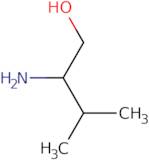2-Amino-3-Methyl-1-Butanol
CAS: 16369-05-4
Ref. 3D-FA57587
| 5g | Discontinued | ||
| 10g | Discontinued | ||
| 25g | Discontinued | ||
| 50g | Discontinued | ||
| 100g | Discontinued |
Product Information
- (2R)-1-hydroxy-3-methylbutan-2-aminium
- (2S)-1-hydroxy-3-methylbutan-2-aminium
- (±)-2-Amino-3-methyl-1-butanol
- (±)-Valinol
- 1-Butanol, 2-amino-3-methyl-
- 1-Butanol, 2-amino-3-methyl-, <span class="text-smallcaps">D</smallcap><smallcap>L</span>-
- 2-Amino-3-Methylbutan-1-Ol
- 2-Amino-3-methylbutanol
- 3-Methyl-2-aminobutanol
- <span class="text-smallcaps">D</smallcap><smallcap>L</span>-Valinol
- See more synonyms
- DL-Valinol
- N-(1-Hydroxy-3-methylbutan-2-yl)amine
- [1-(Hydroxymethyl)-2-methylpropyl]amine
- rac-Valinol
- 1-Butanol, 2-amino-3-methyl-, DL-
2-Amino-3-Methyl-1-Butanol is a hydrophilic interaction chromatography (HILIC) stationary phase. It is used in the analysis of fatty acids, amino acids, amides and other polar compounds. HILIC is a type of chromatography that separates molecules based on their affinity for water and a nonpolar solvent. 2-Amino-3-Methyl-1-Butanol has been shown to be sensitive for the detection of cervical cancer cells. The 2nd amino group reacts with ethyl diazoacetate to produce hydrogen tartrate. Hydrogen tartrate can react with sodium methoxide to form an enolate ion. This enolate ion can then react with hydrogen peroxide to form an alcohol or an alkyl radical. The resulting alcohol reacts with sn-38 as a radioactive marker, yielding positron emission tomography (PET) images that show the location of cancer cells.





